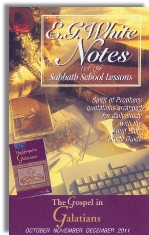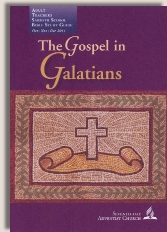|
||||||||||||||
Commentary on "From Slaves to Heirs"
Day 2: Sunday, November 13, 2011 - Our Condition in Christ
Overview
This lesson addresses three main issues:
- Our status as sons/children of God,
- The changed relationship between the Law and the believer, and
- The significance of our baptism.
Observations
The lesson begins with a strong point, encouraging some contextually reading by reminding people to go back a verse and understand the current verse in light of the previous verse. Full contextual reading may require reading an even larger amount of Scripture than just the verse immediately prior, but this concept of contextual study is critical to understanding Scripture as it was written. We can't just study one verse at a time here and there and expect to understand what they meant to the author. The lesson asks:
Keeping Galatians 3:25 in mind, read Galatians 3:26. How does this text help us understand what our relationship to the law is, now that we have been redeemed by Jesus?
Since verse 26 makes no mention of the law, the question must require us looking back to what verse 25 says. Verse 25 tells us that as believers "we are no longer under a guardian". Backing up one more verse, we find in verse 24 that "the law was our guardian", so the Biblical conclusion is that we are no longer under the Law.
The lesson emphasizes that our "relationship" to the law is changed. It tries to explain this as having the relationship as a "minor" before and having an adult "relationship" now. This is misleading. Once the child was grown, the pedagogue no longer had any authority to tell the son what to do. The grown child doesn't subsequently cling to the pedagogue as a trusted advisor. The pedagogue completed the task that the Master had assigned to him and moved on to something else, the grown child had no further relationship with this slave. If we accept the direct and plain words of Scripture we can only conclude that we are no longer under the Law, not that we have a new "relationship" with the Law. The author of the study is slightly, but very importantly, altering the words of Scripture in order to insert their own ideas into the passage. "No longer under" means just what it says.
Verse 26 is not just a reference pointing out that believers become sons (children) of God. The lesson did a nice job of pointing out this aspect of the verse and the implications for inheritance. But there is another important part of this verse that was ignored by the lesson.
...for in Christ Jesus you are all sons of God, through faith. (Gal 3:26, ESV)
One of the critical teachings of this verse, a teaching that links this verse to the discussion that comes before it in the Chapter and the discussions that continue into the next Chapter is the teaching of "how" we become sons (children) of God. The verse makes it clear that it is "through faith", in contrast to the Law which we are no longer under. As we look back in the Chapter, Paul makes it clear that inheritance comes by the promise not by the law (v 18) and then links together the promise and faith (v 22). Going a little further back in the Chapter we find that this entire discussion is based on the question of Law versus faith (v 2). That is the broader context and this verse fits perfectly into that overall context when you don't leave out part of the verse from your discussion.
The focus of verse 26 isn't so much our relationship to the Law and how it changes. Instead it is a question of our status as heirs and children of God and how that status comes about. We are sons/heirs through faith, not because of works of the Law.
The lesson then moves from being children of God to the question of Baptism. The author claims that "Paul sees baptism as a radical decision" and as eloquent as this sounds, it simply isn't Biblical. The author sees baptism this way and attributes that teaching to Paul. But there are no passages from Paul describing baptism as a "decision", let alone a radical one. Theological viewpoints are reinforced through repeating statements like these as if they were truth. Avoid being manipulated by looking for the Scriptural support for the statements.
The author also attributes the notion that Paul describes baptism as a symbolic uniting with Jesus. But the new birth associated with baptism is more than a symbolic union with Christ. Jesus describes it as being born of the water and the Spirit (John 3:5). When we are born again, the Holy Spirit comes to dwell in us. The Holy Spirit is God's seal (Eph 1:13) and it guarantees our status as His children and His heirs (Eph 1:14; Rom 8:16; 2 Cor 1:22).
The lesson quotes a Roman Catholic professor regarding the events that accompany baptism when he notes that "Paul is describing the righteousness which is conferred upon believers". It is interesting that the author of this lesson would choose a quote that was so carefully worded. Conferred has two accepted meanings, but those two meanings are drastically different theological teachings. Conferred can mean the credited (i.e. imputed) righteousness described by Paul in Romans. But "conferred" can also be used to describe the infused righteousness taught by works-oriented religions like Roman Catholicism and historic Seventh-day Adventism. By carefully selecting a word that can mean either one, the author can not be pinned down on whether his views are Biblically accurate.
The lesson ends with one of those question types that I remember as being so popular among SDA Sabbath School class; a question that is based completely on speculation and philosophy. Instead of focusing on what the Scripture being studied actual says, the question asks for speculative extensions of a concept found in the lesson. Because we are heirs like Christ is an heir, doesn't mean that everything that is true of Christ is also true of us. Such speculation is a dangerous practice where we substitute our wisdom for the plain Word of God. It is also a substantial tangent that avoids the key point of the passage under study that we are children of God through faith not through the Law.
Summary
The quarterly lesson glosses over key phrases in the passages studied and fails to link together the current passages with the surrounding passages. The author of the study introduces small modifications to the teaching of Scripture, repeating these as if they were facts. The questions tended to address tangential elements of the passage, directing people away from the strong points made in Scripture that would raise questions about SDA doctrine. Unfortunately, people can follow these tangents and think that they actually studied the Bible while having been lead away from a few of the core teachings.
Copyright 2011 BibleStudiesForAdventists.com. All rights reserved. Revised November 2, 2011. This website is published by Life Assurance Ministries, Glendale, Arizona, USA, the publisher of Proclamation! Magazine. Contact email: BibleStudiesForAdventists@gmail.com.
The Sabbath School Bible Study Guide and the corresponding E.G. White Notes are published by Pacific Press Publishing Association, which is owned and operated by the Seventh-day Adventist church. The current quarter's editions are pictured above.
Official Adventist Resources
Standard Edition Study Guide Week 8
Teacher's Edition Study Guide Week 8
Easy Reading Edition Study Guide Wk 8
Search the Complete Published Ellen G. White Writings
Please Support This Project


